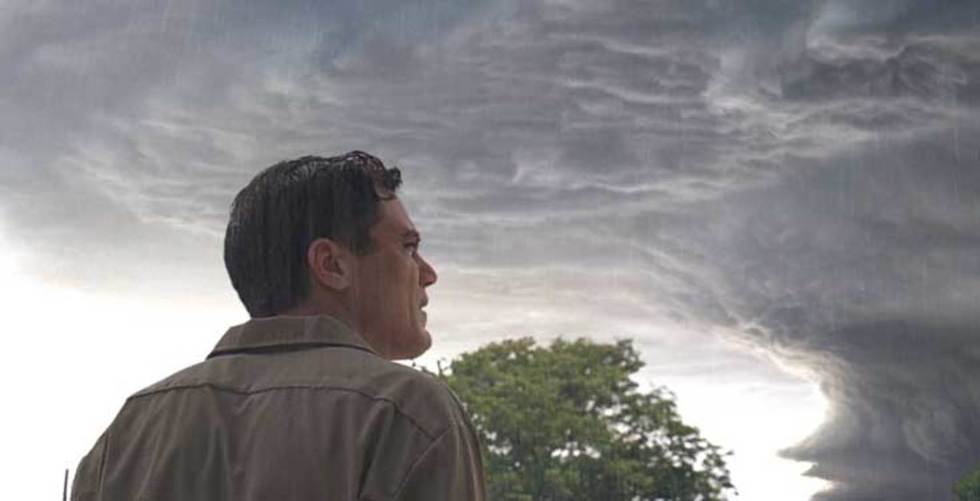
BY ZACHARY WIGON |
Take Shelter: Crafting the Perfect Storm
Director Jeff Nichols talks about anxiety, family, and the upcoming storm to end all storms.


Photo credit: Grove Hill Productions / Courtesy of Sony Pictures Classics
It’s often quite interesting how, with a slightly elevated attention to character detail and with above-average acting, movies that would have otherwise been simple genre exercises can be turned into much, much more. Many successful indie films over the past few years have been steeped in a narrative formula that is straight genre, but rise above their station due to the fact that they pay attention to detail in a way that most movies don’t. Tiny Furniture, in different hands, could have been a by-the-book coming-of-age movie; Drive, the new film by Nicholas Winding Refn, could have been a generic action movie if not handled with such attention to style and form.
Into this pile we can toss Jeff Nichols’ Take Shelter, a pseudo-thriller that is as careful and nuanced a character study as any this critic has seen this year. Ostensibly about a man (Michael Shannon) who sees apocalyptic visions, and fears for both his family’s safety and his own mental health, the film is really a study in family dynamics, relationship dynamics, and how people cope with adversity. Bolstered by the impending sense of doom that permeates America in 2011 — looming economic crisis, looming environmental catastrophe, etc. — the film’s suggestion of a kind of doomsday prophesy is all too resonant. But as the film’s protagonist becomes more and more terrified as to what the future may hold, and the film begins to shape up more and more like a traditional thriller, Nichols delves further into the psyches of Shannon and his wife, played by Jessica Chastain, adding a layer of character development not typically found in such films. Shannon and Chastain both shine in their well-written roles. I had the chance to sit down with Nichols recently and speak with him about the film.

Photo credit: Scott Gardner / Courtesy of Sony Pictures Classics
Tribeca: The lead performances in your film are really excellent. Can you tell me a bit about your method in terms of working with actors?
Jeff Nichols: The thing about actors is, they’re all different people. Each actor, you have to find a way to speak to them, and communicate with them. Mike Shannon doesn’t like to rehearse at all — at least, when he works with me. So we would just set up the camera, and we’d barely do a walk-through. In terms of hearing the lines, we’d just jump right in. Outside of production, we didn’t talk a lot about his character. He just got it.
Shea Whigham, though, who played his friend, another great actor, has a totally different style. We went out and had pizza when he first got to Ohio, and we talked for an hour and a half, getting into his character. I can go either way. I think as a director it’s your job to figure out how best to communicate with your actors.
Jessica was in the middle. There were some things that she didn’t need to talk about, but there were others that she did — Jessica loves to sit down and talk about where the character was right before the scene, and where she’s going to right after, to make sure those dots connect. But I don’t really have people improv — I like to stick to the script. You’re always modifying your plan based on constraints, so things are always in flux, but I’m not the kind of guy who encourages riffing on a scene for a few takes.
Tribeca: So if you’re doing a scene with Mike Shannon and Shea Whigham — Shannon doesn’t like preparation, Whigham does — how do you navigate that?
Jeff Nichols: Mike kind of took the lead in those scenes. Shea didn’t demand rehearsals, he just wanted to talk things out beforehand — talk about the character. The good thing about Mike and Shea is they’re friends. They’re both great actors, but I think the fact that they’re friends helped.
Tribeca: So what was the beginning of discussing the project with Shannon like, since he doesn’t really prep?
Jeff Nichols: Well, Mike was in my first film [Shotgun Stories, TFF 2007], and in that film I wrote the part for him. He’s a buddy of mine, extremely intelligent, so I sent him this script as a friend, to see what he thought. He called me and he liked it, so when we got around to casting, I didn’t have anyone in the role in mind, and I wasn’t going to get Brad Pitt, you know? I didn’t want to go through that process, of trying to pair some big famous movie star with this part, given our budget. I kept thinking about Mike.
I wrote this part for myself, really, and I wanted to have Curtis be an everyman, and you don’t necessarily think of Mike Shannon as an everyman, but I was on the phone with him one day and I heard him talking to his daughter, and it just sounded different from any other version of Mike Shannon I’d heard. And I thought, "That’s really interesting." He also has an underlying well of empathy. I think that certainly came out in this film. So it became a natural choice. So I called him up, and I said, I need you in this movie, and he said of course. I owe him a lot.
Tribeca: So once that happened, you guys didn’t really discuss the character.
Jeff Nichols: Yeah. The most we talked about was his clothes. And the way he walks. The reason for that — his character in Shotgun Stories was really low down on the socio-economic level, and Curtis isn’t — he’s working-class, but he’s working middle-class. So there were differences between the characters, and because it was my first and second film, and he’d been in both, we wanted to delineate between those. So we talked about subtle things like that, to separate the two characters. But in terms of intention and whatnot, Mike just kind of filled that in.
Tribeca: Obviously there are a lot of real-world reference points that we can think about in terms of an apocalyptic storm headed our way. What made you want to treat those things, in this movie, in a kind of abstract, metaphorical way as opposed to in a more blunt way?
Jeff Nichols: I think the bigger issue isn’t about dealing with one conflict or one disaster — obviously, you have to deal with that — but this movie isn’t about overcoming one thing in your life. It’s about dealing with a general sense of anxiety that we all carry with us, to varying degrees of intensity. It’s not, "How do I survive a disaster?" It’s, "How do I survive life and deal with these stresses?" Because they don’t seem to go away. They just develop and morph and mature, but I still have just as much, if not more stress, than I did four years ago. Everybody has to find a way in their life to overcome what, at times, can be the paralyzing effect of fear and anxiety.
Storms happen to be a good visual metaphor. Plus, they’re just cool looking. There’s an energy there. These storms, they’re not just terrifying, they’re awe-inspiring. I find it interesting. I think that’s kind of what life is like — these things that terrify us are these things that we’re also amazed by.
Tribeca: And it’s interesting how the way we try to assuage those anxieties can also kind of be our undoing, which is something you deal with nicely here.

Photo credit: Grove Hill Productions / Courtesy of Sony Pictures Classics
Jeff Nichols: It was interesting, because I like to think about an overarching theme before I sit down to write. I got into this, and I realized this was about more than just anxiety. It’s when Jessica Chastain’s character started to develop, and the idea of marriage started to develop. It’s the idea of unraveling — in order for this guy’s life to unravel, you have to give him stuff to lose. That was a direct reflection of what was happening in my life — I was starting to put the puzzle pieces together for a family, and that increases your anxiety because you have stuff to lose. The ideas of anxiety and family quickly became graphed on top of each other. Anxiety is an effect, and family, to a degree, is the cause. So what started as an attempt to chart an unraveling became an examination of family.
Tribeca: One of the things about your narrative skills is that, in someone else’s hands, this movie could have been a kind of more generic thriller — if the characters were less developed and the relationships weren’t as believable. When you were putting it together, did you see how it could potentially be a sort of thriller, or did that kind of grow organically without you realizing?
Jeff Nichols: I don’t think a lot about plot. I don’t think in three-act structure. You gain things from that. What I gain is, I don’t write plot points, but I do write character points. Plot comes out of character. That’s the best safeguard I have as a filmmaker to elevate my characters. The best thing you can do is get the audience to attach themselves to the people onscreen, and it’s very hard to do. I’m not saying I’ve done that, I’m just saying that’s my goal. So many films are executed well, but you never tie in or connect to the characters. If you can create an emotional connection, I think you have a shot of getting in people’s heads. That’s my general approach to storytelling — plot through character, not through narrative structure or impact. That’s why some people say my movies are slow — which I’ll take.
The other thing is, I came out of Shotgun Stories and I saw the collapse of American independent film, and I wanted to get another film made. And I didn’t have anything — I was going to make this film with Killer Films, and it fell through, and I was looking at the marketplace, talking to agents, and I decided to make a hybrid film. I wanted to take genre elements and weave them into a drama. That was a very clear decision on my part. It was an experiment — I didn’t know how much genre or drama to mix, what I could get away with — and I wondered if some people would wish it had more of one or the other. But it was a conscious decision.
Take Shelter opens Friday, September 30, in New York (Lincoln Plaza and Angelika) and LA, wide in October. Find tickets.
 Check in to Take Shelter on GetGlue.
Check in to Take Shelter on GetGlue.Watch the trailer: